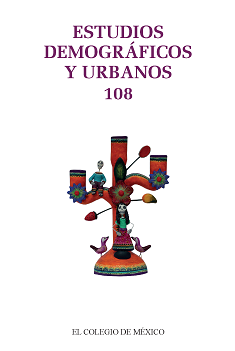El Índice de Sociedad Sostenible (SSI) en América: análisis desde una perspectiva de Biplot dinámico
Publicado 2021-09-17
Palabras clave
- análisis multivariante,
- sostenibilidad,
- Biplot,
- indicadores de desarrollo sostenible,
- estadística multivariante
Cómo citar
-
Resumen1395
-
PDF (español)523
-
En línea (español)58
Descargas
Derechos de autor 2021 Estudios Demográficos y Urbanos

Esta obra está bajo una licencia internacional Creative Commons Atribución-NoComercial-SinDerivadas 4.0.
Métrica
Resumen
Este estudio presenta un análisis mediante Biplot dinámico del Índice de Sociedad Sostenible aplicado a América. Los principales resultados al analizar las trayectorias de las variables en general son cortos, pero tienden a mejorar. Se observaron dos grupos: uno de países bien posicionados frente a las variables “necesidades básicas” y “desarrollo personal y social” (Norteamérica), y el segundo, de países con trayectorias de comportamiento irregular, con poca estabilidad y con una tendencia de caída en los últimos periodos en análisis (Centro, Sudamérica y Caribe). El método Biplot dinámico demuestra ser un nuevo enfoque para el procesamiento de datos de tres vías y provee resultados fáciles de representar e interpretar.
Referencias
- Brundtland, G. H. (1987). Report of the World Commission on Environment and Development: Our common future. United Nations. https://sswm.info/sites/default/files/reference_attachments/UN%20WCED%201987%20Brundtland%20Report.pdf
- Cracolici, M. F., Cuffaro, M. y Nijkamp, P. (2010). The measurement of economic, social and environmental performance of countries: A novel approach. Social Indicators Research, 95(2), 339-356. https://www.ncbi.nlm.nih.gov/pubmed/19966915 DOI: https://doi.org/10.1007/s11205-009-9464-3
- Crepaz, M. (1995). Explaining national variations of air pollution levels: Political institutions and their impact on environmental policy-making. Journal Environmental Politics, 4(3), 391-414. https://www.tandfonline.com/doi/abs/10.1080/09644019508414213 DOI: https://doi.org/10.1080/09644019508414213
- Egido, J. (2017). dynBiplotGUI: Full interactive GUI for Dynamic Biplot in R. R package version 1.1.5. https://CRAN.R-project.org/package=dynBiplotGUI
- Egido, J. y Galindo, P. (2015). Dynamic Biplot. Evolution of the economic freedom in the European Union. British Journal of Applied Science and Technology. 11(3), 1-13. http://www.journalrepository.org/media/journals/BJAST_5/2015/Aug/Egido1132015BJAST20289.pdf DOI: https://doi.org/10.9734/BJAST/2015/20289
- Gabriel, K. (1971). The Biplot graphic display of matrices with applications to principal components analysis. Biometrika, 58(3), 453-467. https://www.jstor.org/stable/2334381?seq=1#page_scan_tab_contents DOI: https://doi.org/10.1093/biomet/58.3.453
- Galindo, M. (1986). Una alternativa de representación simultánea: HJ-Biplot. Questiió, Quaderns d´Estadística, Sistemes, Informatica i Investigació Operativa, 10(1), 13-23. https://dialnet.unirioja.es/servlet/articulo?codigo=2360880
- Gallego-Álvarez, I., Galindo-Villardón, M. P. y Rodríguez-Rosa, M. (2015). Analysis of the sustainable society index worldwide: A study from the Biplot perspective. Social Indicators Research, 120(1), 29-65. https://link.springer.com/article/10.1007/s11205-014-0579-9 DOI: https://doi.org/10.1007/s11205-014-0579-9
- Giles, D. y Feng, H. (2005). Output and well-being industrialized nations in the second half of the 20th century: Testing for convergence using fuzzy clustering analysis. Structural Change and Economic Dynamics, 16(2), 285-308. https://www.sciencedirect.com/science/article/abs/pii/S0954349X0400058X DOI: https://doi.org/10.1016/j.strueco.2004.08.001
- Hausmann, R., Rodrik, D. y Velasco, A. (2008). Growth diagnostics. En N. Serra y J. E. Stiglitz (eds.), The Washington consensus reconsidered. Towards a new global governance (pp. 324-355). Londres: Oxford University Press. DOI: https://doi.org/10.1093/acprof:oso/9780199534081.003.0015
- Jahn, D. (1998). Environmental performance and policy regimes: Explaining variations in 18 OECD-countries. Policy Sciences, 31(2), 107-131. https://link.springer.com/article/10.1023/A:1004385005999 DOI: https://doi.org/10.1023/A:1004385005999
- Neumayer, E. (2003). Are left-wing party strength and corporatism good for the environment? Evidence from panel analysis of air pollution in OCDE countries. Ecological Economics, 45(2), 203-220. https://www.sciencedirect.com/science/article/pii/S0921800903000120 DOI: https://doi.org/10.1016/S0921-8009(03)00012-0
- R Core Team (2018). R: A language and environment for statistical computing. R Foundation for Statistical Computing. Viena, Austria. https://www.gbif.org/es/tool/81287/r-a-language-and-environment-for-statistical-computing
- Rodrik, D. (2007). One economics, many recipes: Globalizations, institutions and economic growth. Princeton, New Jersey: Princeton University Press. DOI: https://doi.org/10.1515/9781400829354
- Scruggs, L. (1999). Institutions and environmental performance in seventeen western democracies. British Journal of Political Science, 29(1), 1-13. https://ideas.repec.org/a/cup/bjposi/v29y1999i01p1-31_00.html DOI: https://doi.org/10.1017/S0007123499000010
- Scruggs, L. (2001). Is there really a link between neo-corporatism and environmental performance? Updated evidence and new data for the 1980s and 1990s. British Journal of Political Science, 31(4), 686-692. https://www.jstor.org/stable/3593298?seq=1#page_scan_tab_contents DOI: https://doi.org/10.1017/S0007123401220262
- Scruggs, L. (2003). Sustaining abundance. Environmental performance in industrial democracies. Cambridge: Cambridge University Press. https://doi.org/10.1017/CBO9780511615689 DOI: https://doi.org/10.1017/CBO9780511615689
- Van de Kerk, G. y Manuel, A. (2014). Sustainable Society Index-SSI 2014. Países Bajos: Sustainable Society Foundation. https://ssi.wi.th-koeln.de/documents/ssfindex/ssi-2014.pdf
- World Bank. (2017-2018). World Bank list of economies. www.worldbank.org



